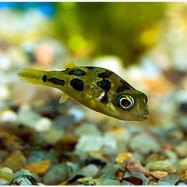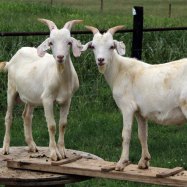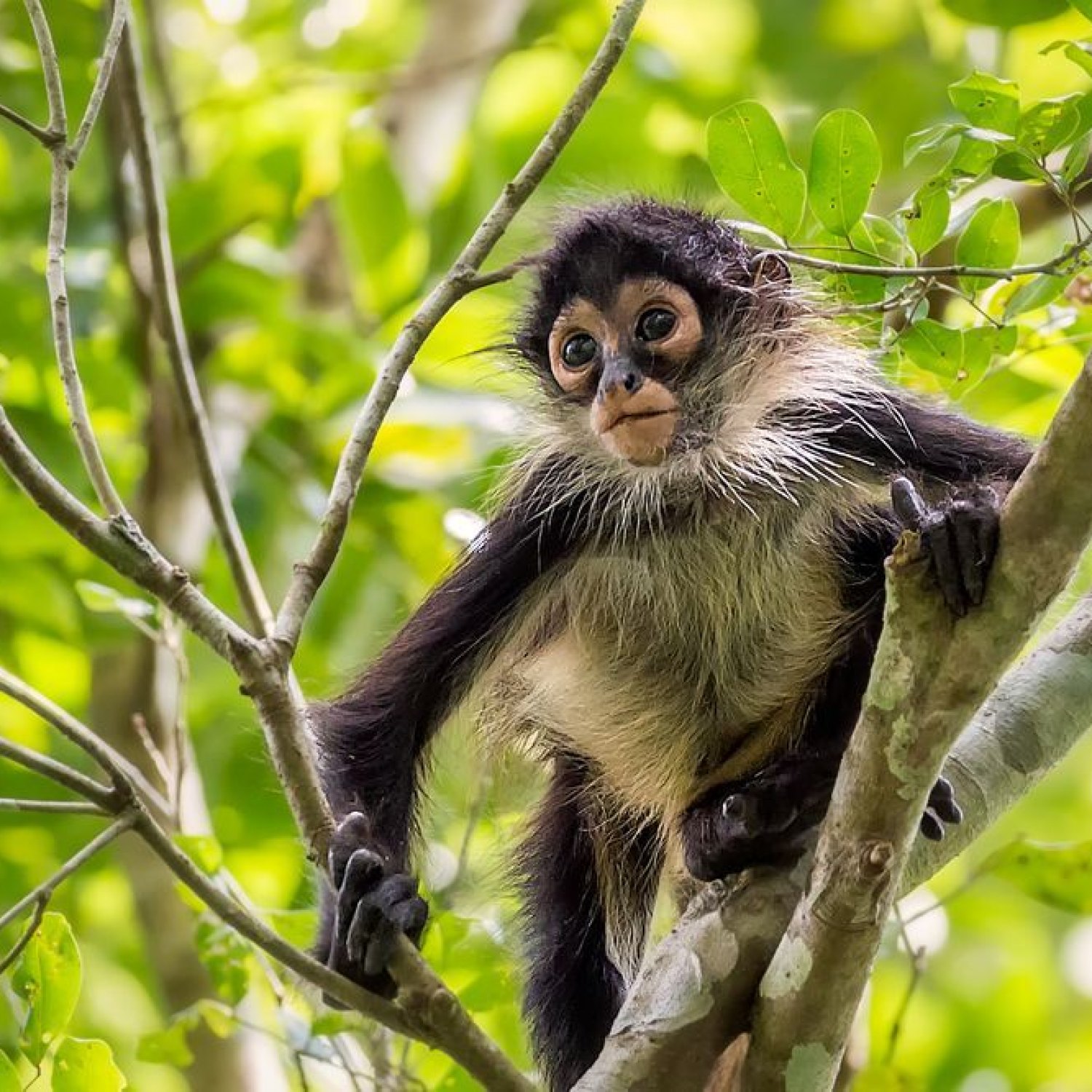
Spider Monkey
42-73 centimeters
Spider monkeys are fascinating creatures found in the rainforests of Central and South America. With a slender body and long limbs, they can reach a length of 42-73 cm. Belonging to the Atelidae family, these agile primates are known for their remarkable ability to swing through the trees. Their curious nature and social behaviors make them a popular sight among tourists in the rainforests. Keep an eye out for these playful and intelligent creatures on your next visit to the rainforest! #SpiderMonkey #Rainforest #CentralAmerica #SouthAmerica #Atelidae.
Animal Details Summary:
Common Name: Spider Monkey
Kingdom: Animalia
Habitat: Tropical rainforests
The Fascinating World of Spider Monkeys: A Closer Look at Nature’s Acrobat
Spider monkeys, also known by their scientific name Ateles geoffroyi, are one of the most well-known and beloved species of primates in the animal kingdom. Their unique appearance, agile movements, and intelligent behaviors have captivated the hearts and minds of many, making them a firm favorite among wildlife enthusiasts and researchers alike.Native to Central and South American tropical rainforests, these primates have been the subject of numerous studies and have paved the way for a better understanding of primate behavior and evolution. In this article, we will take a closer look at the fascinating world of spider monkeys, exploring their physical traits, behaviors, and their crucial role in maintaining the balance of their ecosystem Spider Monkey.
The Spider Monkey Family
Spider monkeys belong to the Animalia kingdom, which encompasses all living organisms that are multicellular, heterotrophic, and exhibit characteristic movements. They also belong to the phylum Chordata, which includes all animals that have a notochord, or a flexible rod-like structure that provides support for their bodies. This phylum also includes two of the most well-known animal classes – fish and mammals.As primates, spider monkeys are classified as part of the mammalia class, which includes all warm-blooded animals characterized by the presence of mammary glands and hair on their bodies. Within this class, spider monkeys belong to the order Primates, which also includes other well-known species such as monkeys, apes, and lemurs. And within the primate order, spider monkeys are part of the family Atelidae, also known as the New World monkeys.
Heavenly Habitat
The natural habitat of spider monkeys is primarily in the tropical rainforests of Central and South America. These areas are characterized by high levels of rainfall, dense vegetation, and a wide variety of plant and animal species. This provides an ideal environment for the spider monkeys, who thrive in the lush greenery and abundant food sources Siberian Tiger.Within the rainforest, spider monkeys can be found at varying altitudes, ranging from sea level up to 3000 meters. They are most commonly found in the upper levels of the canopy, making use of their long, agile limbs to navigate and forage for food. These primates are also found in large, multi-male and multi-female groups, making them highly social animals.
Feasting on Foliage
Spider monkeys are herbivorous, meaning they primarily feed on plant matter. Their diet consists mainly of fruits, leaves, stems, flowers, and insects. As their habitat provides an abundant supply of food sources, they have a diverse diet, constantly foraging for new and interesting items to munch on.Interestingly, spider monkeys have a unique method of feeding – they use their prehensile tails for support and balance while picking fruits and leaves with their long, slender fingers. This gives them the appearance of a spider, hence their name. This also allows them to move swiftly throughout the canopy, making them highly efficient predators of their environment.
Distinctive Features of Spider Monkeys
One of the most fascinating aspects of spider monkeys is their physical traits and features that make them stand out from other primates. Let’s take a closer look at some of these remarkable characteristics.Geographic Distribution
The geographic distribution of spider monkeys is widespread, as they can be found in various tropical rainforests within Central and South America. They can be found in countries such as Mexico, Guatemala, Costa Rica, Brazil, and Peru, making them an integral part of the diverse ecosystems of these regions.Coloration and Body Shape
The coloration of spider monkeys varies depending on their subspecies, but they are typically black or dark brown in color, with a lighter face and a white patch on their throat. This coloration helps them blend in with the dense vegetation of their habitat, offering protection from potential predators.In terms of body shape, spider monkeys are known for their long, slender bodies and limbs. Their limbs are longer than their torso, allowing them to move adeptly through the forest canopy. These limbs are also powerful, providing them with the agility and dexterity needed for their daily activities, such as climbing and foraging.
Size and Length
On average, spider monkeys measure between 42 to 73 centimeters in length, with males being larger and heavier than females. Their tails, which can measure up to one meter in length, make up a significant portion of their overall body length. This allows them to use their tails for stability and balance, making them true acrobats of the jungle.The Importance of Spider Monkeys in the Ecosystem
As with any species, spider monkeys play a critical role in maintaining the delicate balance of their ecosystem. They are essential for seed dispersal, as they consume a wide variety of fruits and plants. This allows them to travel throughout the forest, depositing seeds in different locations, promoting the growth of new trees and plants.These primates also act as a food source for other animals, such as larger predators like jaguars and birds of prey. This makes them an integral part of the food chain, ensuring a healthy and functioning ecosystem. They also contribute to the pollination of various plants, making them crucial in the reproduction of many plant species in their habitat.
The Threats Facing Spider Monkeys
Unfortunately, the spider monkey population is facing several threats that are endangering their survival. One of the main threats is deforestation, as their natural habitat is continuously being destroyed to make way for urban development and agriculture. This disrupts their ability to move and forage for food, and also exposes them to potential threats from humans.Spider monkeys are also hunted for their meat, which is considered a delicacy in some parts of Central and South America. This, coupled with the destruction of their habitat, has led to a severe decline in their population in recent years. According to the International Union for Conservation of Nature, spider monkeys are currently listed as vulnerable on the Red List of Threatened Species.
In Conclusion
Although spider monkeys may not be the largest or most well-known species in the animal kingdom, they hold a unique and essential role in our ecosystem. From their fascinating physical traits and behaviors to their crucial contribution to the delicate balance of their habitat, these primates are truly one of nature’s acrobats.As we continue to learn more about these incredible creatures and the threats facing them, it is vital that we take steps to protect and preserve their habitat. This not only ensures the survival of spider monkeys but also supports the health and sustainability of our planet as a whole. So let us all do our part in preserving the beauty and diversity of the natural world for future generations to come.

Spider Monkey
Animal Details Spider Monkey - Scientific Name: Ateles geoffroyi
- Category: Animals S
- Scientific Name: Ateles geoffroyi
- Common Name: Spider Monkey
- Kingdom: Animalia
- Phylum: Chordata
- Class: Mammalia
- Order: Primates
- Family: Atelidae
- Habitat: Tropical rainforests
- Feeding Method: Herbivorous
- Geographical Distribution: Central and South America
- Country of Origin: Multiple countries including Mexico, Guatemala, Costa Rica, Brazil, and Peru
- Location: Can be found in the rainforests of Central and South America
- Animal Coloration: Black or brown fur with lighter colored faces
- Body Shape: Slender body and long limbs
- Length: 42-73 centimeters
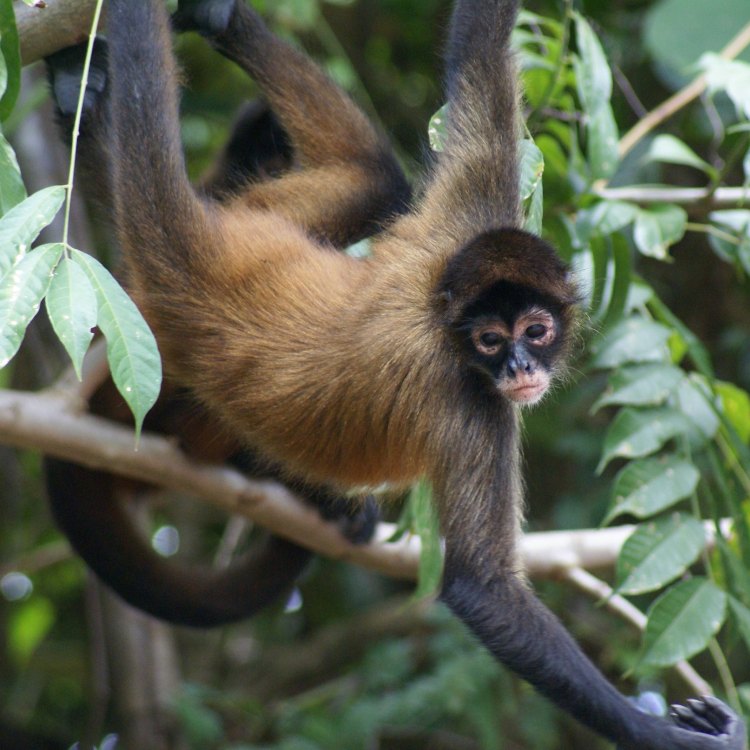
Spider Monkey
- Adult Size: Weight: 7-10 kilograms
- Average Lifespan: 20-27 years in the wild
- Reproduction: Sexual
- Reproductive Behavior: Females give birth every 2-4 years
- Sound or Call: Loud vocalizations including high-pitched calls
- Migration Pattern: Non-migratory
- Social Groups: Live in large groups called troops
- Behavior: Highly arboreal, spend most of their time in trees
- Threats: Habitat loss, hunting, and illegal pet trade
- Conservation Status: Endangered
- Impact on Ecosystem: Seed dispersers, help with forest regeneration
- Human Use: Hunted for meat, captured for the illegal pet trade
- Distinctive Features: Prehensile tail, long limbs
- Interesting Facts: Spider monkeys are known for their ability to move swiftly through trees using their long limbs and prehensile tail
- Predator: Jaguars and large birds of prey
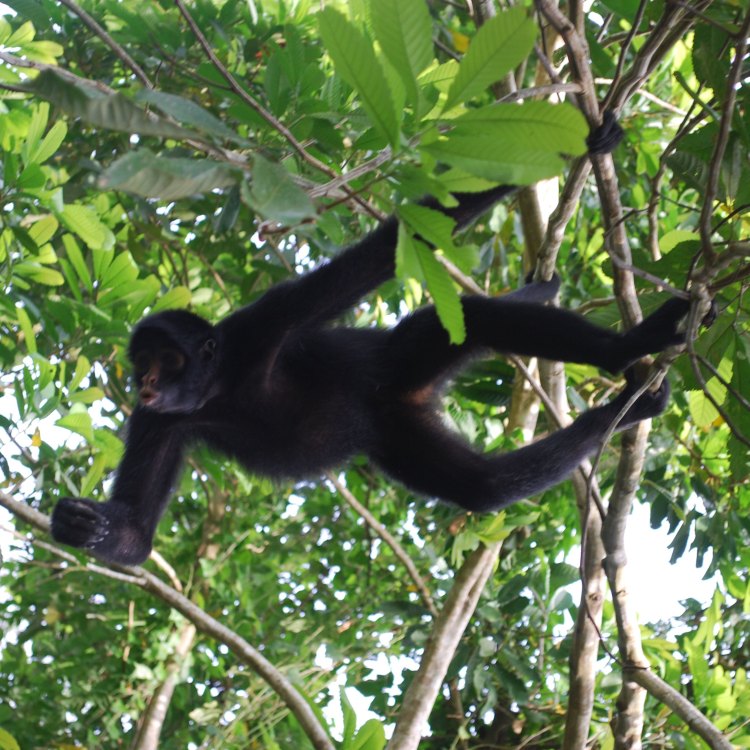
Ateles geoffroyi
The Agile Acrobats of the Forest: The Fascinating World of Spider Monkeys
Nestled in the dense, tropical rainforests of Central and South America, lives a treasured species that has captured the hearts of many - the spider monkey. These agile acrobats of the forest are known for their remarkable ability to move swiftly through trees, making them seem almost weightless as they swing and leap from branch to branch. But besides their impressive acrobatic skills, spider monkeys are a species that is full of unique and interesting features, each contributing to their survival and impact on their ecosystem.Adult spider monkeys may seem small compared to other primate species, with an average weight of 7-10 kilograms PeaceOfAnimals.Com. However, don't let their size fool you, as they are intelligent, social, and highly skilled at adapting to their environment. They have an average lifespan of 20-27 years in the wild, showing their resilience and adaptability in their natural habitat.
Reproduction in spider monkeys follows a sexual pattern, with females giving birth every 2-4 years. This reproductive behavior allows them to maintain a stable and sustainable population in their habitat. Females are the primary caregivers, often carrying their young on their backs as they travel through the trees.
In addition to their reproductive behaviors, spider monkeys are also known for their loud vocalizations, including high-pitched calls that can be heard from afar. These vocalizations are integral in communication within their troops and can indicate danger, territorial disputes, or calls for social interaction.
Unlike some other primate species, spider monkeys are non-migratory, meaning they do not have a specific migration pattern. Instead, they stay within their home range, which can vary in size depending on the habitat and availability of resources Saiga. Within their home range, they live in large groups called troops, consisting of 20-40 individuals, with males and females living in harmony.
Spider monkeys' highly arboreal nature is a defining feature of their behavior. It means that they spend most of their time in trees, using their remarkable agility and dexterity to navigate through the dense canopies. They have a unique anatomical adaptation that enables them to do so - their long limbs and prehensile tail.
Their limbs allow them to move swiftly through the trees, while their prehensile tail acts as an extra limb, providing stability and balance as they swing and jump from branch to branch. This remarkable feature makes them excellent climbers and allows them to reach for fruits and seeds in the upper canopy that other species cannot access.
Unfortunately, with human expansion and deforestation, spider monkeys face increasing threats to their survival. Habitat loss, hunting, and the illegal pet trade are major risks to their populations. The destruction of their habitat means less food and resources for survival, while hunting and the pet trade directly impact their populations.
As a result, spider monkeys are currently listed as endangered on the International Union for Conservation of Nature (IUCN) Red List. Conservation efforts are in place to protect and preserve their populations, but it will require a collective effort to ensure their survival in the wild.
One crucial aspect of spider monkeys' role in their ecosystem is their impact as seed dispersers. As they travel through the treetops, they eat a variety of fruits and seeds, which then gets dispersed throughout the forest. This process helps with forest regeneration and contributes to maintaining a healthy and diverse ecosystem. Without spider monkeys, the forests they inhabit could potentially suffer from a lack of seed dispersal and struggle to regenerate.
Unfortunately, humans also have a long-standing history of exploiting spider monkeys for their own use. They have been hunted for their meat, which is considered a delicacy in some parts of their range. They have also been captured for the illegal pet trade, where they are often kept in small, confined spaces and suffer from physical and psychological trauma.
But despite the threats and challenges they face, spider monkeys continue to captivate us with their unique features and behaviors. Here are a few interesting facts about these amazing primates:
- Spider monkeys have been observed using tools, such as using sticks to scoop out insects from trees.
- They have a keen sense of smell and can identify ripe fruits from a distance.
- In addition to their prehensile tail, spider monkeys also have gripping ability with their feet, allowing them to hang upside down from branches.
- They have a complex social structure, with different relationships and hierarchies within their troops.
As with any species, spider monkeys also have natural predators in their environment. Jaguars and large birds of prey are known to hunt and prey on spider monkeys, and as a result, these primates have developed specific behaviors to avoid being hunted. They often travel in large, noisy groups, making it more challenging for predators to single them out.
In conclusion, the spider monkey species is an extraordinary and fascinating part of the tropical rainforests they call home. Their prehensile tail, long limbs, loud vocalizations, and impressive acrobatic skills are just some of the unique features that make them stand out. Unfortunately, they face significant threats to their survival, but with conservation efforts and awareness, we can help protect these agile acrobats of the forest for generations to come.
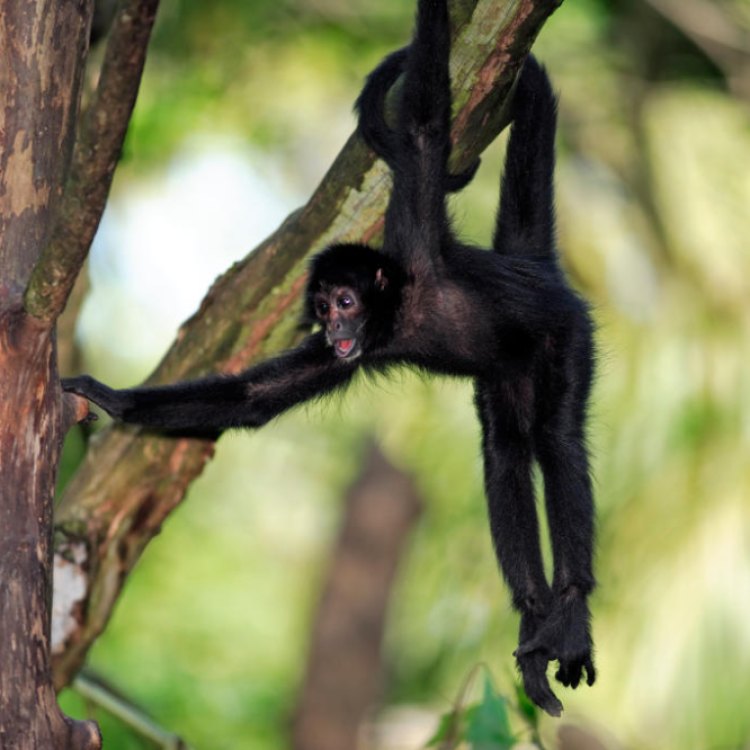
The Fascinating World of Spider Monkeys: A Closer Look at Nature’s Acrobat
Disclaimer: The content provided is for informational purposes only. We cannot guarantee the accuracy of the information on this page 100%. All information provided here may change without prior notice.


